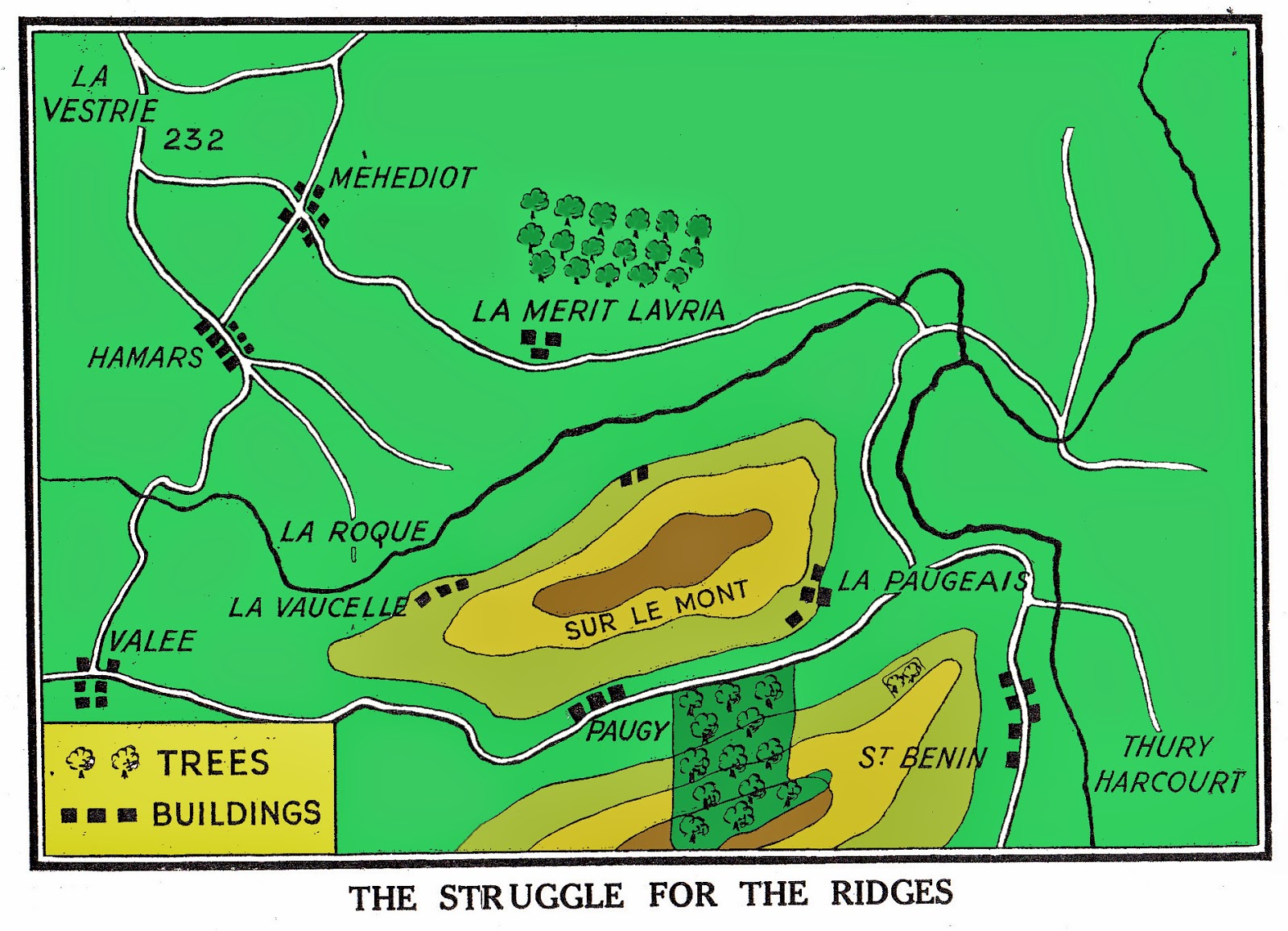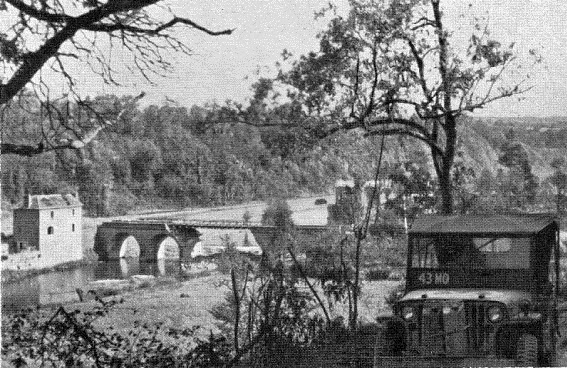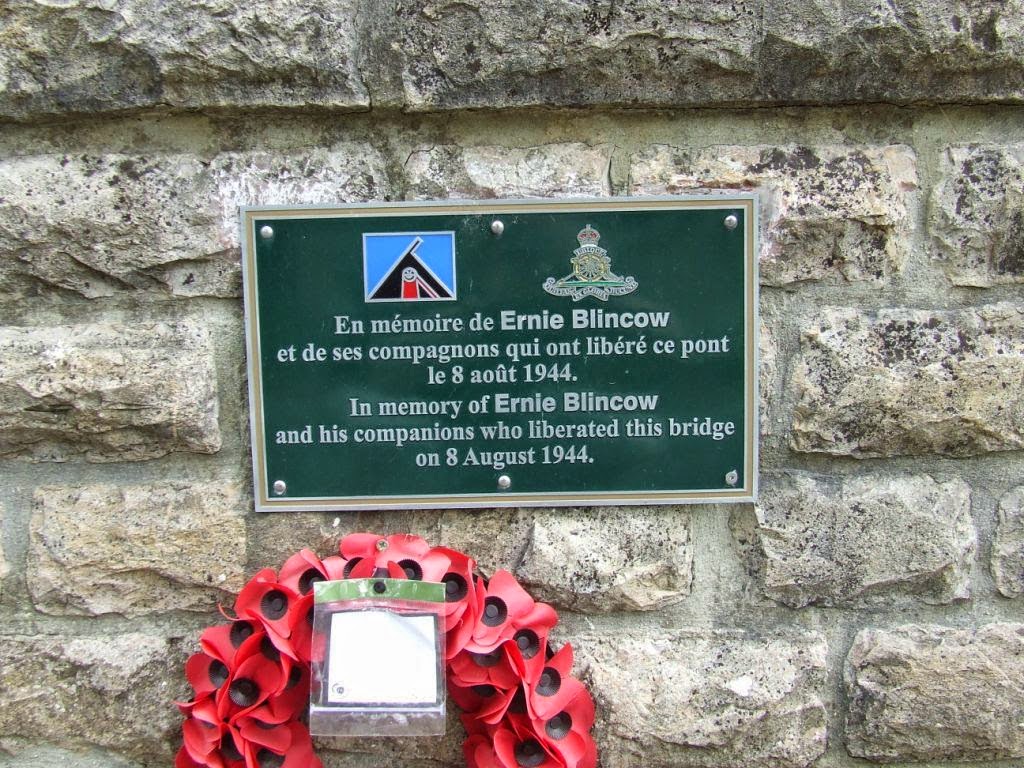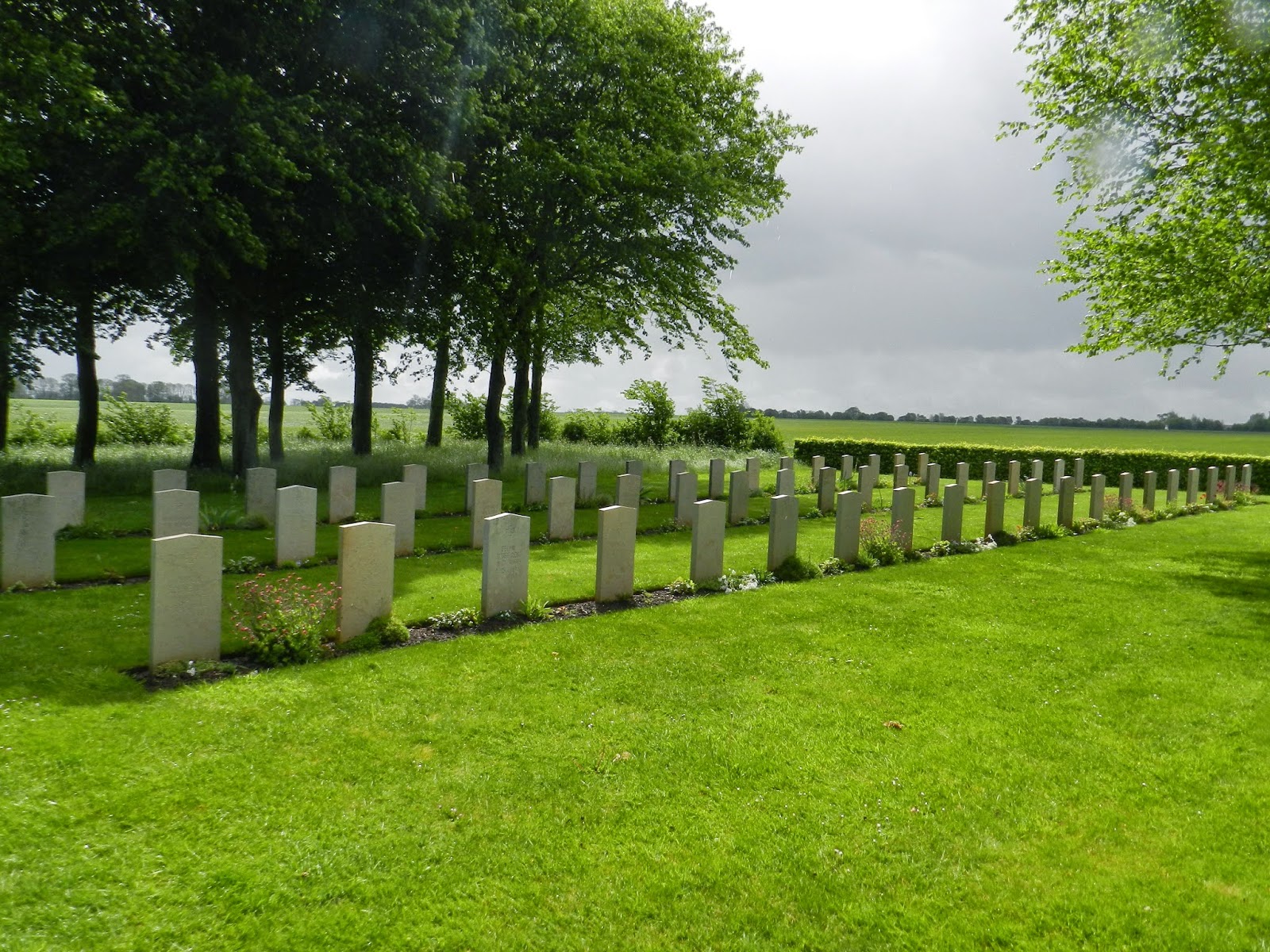Map indicating the positions of opposing forces in the Orne Bridgehead 6th to 9th August 1944
(with thanks to http://59div.morssweb.com/)
As previously observed by Colonel Douglas, the units of the 59th Division suffered very badly in their repeated attempts to capture the village of Noyers. However, at this point in the campaign it was necessary to maintain the offensive and to this end the South Staffordshire Regiments were destined to suffer even greater casualty numbers in the last three weeks of the Division’s existence.
From the beginning of August, the tide was turning in Normandy as the ability of the German forces to oppose an enemy having almost complete control of the air and such an overwhelming superiority in equipment was nearing its end. Cracks started to appear in the German defences which ultimately opened up to the extent that the entire German 7th Army and the 5th Panzer Army (albeit much depleted in strength) became encircled by British, Canadian and U.S. forces and were annihilated in the infamous ‘Falaise Pocket’. However, at the beginning of the month this dramatic demise of the German forces in France was three weeks off and the 59th were faced with many more days of hard fighting yet.
In that first week of August, all the regiments of South Staffordshire were moved forward towards the Orne River in what were to be the final series of actions in which they fought as part of the 59 Division.
The prominent role in the advance to the western banks of the Orne and the subsequent formation and defence of the bridgehead was taken up by the 7th South Staffordshire Regiment of 176 Brigade. Orders were received late on the evening of 3rd August that the 7th were to launch an attack towards the Villers Bocage. In doing so the decision was taken to advance across country towards the village as the road was known to be heavily mined. In order to advance in this manner, specialised tanks were brought up which were capable of launching 40 lb T.N.T. charges that cleared the high hedges and banks of the bocage whilst armoured bulldozers cleared the debris to create passages through which the infantry could pass.
The infantry companies began the advance in the early morning of 4th August. From gathered intelligence it was anticipated that resistance would be very light as the enemy had withdrawn from the area, but in doing so had made good use of mines and booby traps laid and set with the intention of impeding the British progress as much as possible.
In the shattered village of Villers Bocage the only inhabitants encountered by the advancing units were discovered to be German wounded and the nursing staff that were tending to them.
By 4 pm the main road from Tilly had been cleared of mines, but the forward movement resulted in gridlock for the mass of transport attempting to move through the area. With the enemy nowhere in sight, orders were passed down to the forward companies of 7th Battalion to advance towards and to occupy a series of prominent positions approximately 10 miles distant from the River Orne.
The fact that contact with the enemy had been lost was a cause for concern within the British command. In order to confirm the enemy’s withdrawal, the divisional ‘Recce’ units headed out in the pre-dawn of 5th August in the direction of the river. Their intelligence reports did indeed confirm that nothing of the enemy was in evidence to the west of the river, other than signs of a hasty retreat, and that the Germans had crossed over the Orne.
By 4 pm that day the forward formations reached the high ground that overlooked the Orne valley and they were able to establish that the stone bridge at La Bas, the only crossing point, had been blown up by the Germans once they had crossed over.
Along roads that ran parallel to those taken by 7th Battalion, but shifted approximately three miles to the south, the formations of 177 Brigade approached and reached the river. By 7 pm the Brigade had concentrated. From the concentration area, the battalions of 177 had gained a good vantage point from which they were able to observe the hurried preparation of new German defensive positions.
The topography of the River Orne was a critical consideration to the Division as they 176 planned the crossing, The river itself runs its course in this area through a deep and narrow valley, the western banks of which are very steep and thickly covered with undergrowth. The river is approximately 50 feet wide and fordable in several places. In contrast the eastern slopes are shallower and the land that runs up from the banks of the river to the dense Grimbosq Forest features orchards, small farms and villages. The forest was approximately two miles wide and one mile deep. The existence of this wooded land directly opposite the planned bridgehead would later offer cover for enemy troop concentrations from which attacks on the bridgehead positions could be launched.
Prior to the crossing, night patrols had identified a couple of crossing points for the troops. The 'War Story' account described how one of them was established, 'in one area the height of the banks was measured by lowering a six-foot officer by his heels from the edge of the bank until he touched water below'. 176 Brigade now had a place to cross where the men would be able to wade across to the opposite bank which a ‘recce’ by Lieutenant Ball, accompanied by a Canadian officer, had established was only lightly defended. However, this would be without supporting armour which due to the steep banks could only cross in the area of La Bas and with the bridge destroyed it would be for the Royal Engineers to position and secure a Bailey bridge next to the blown stone bridge as quickly as possible.
With the South Staffordshire forces congregated across the western banks of the Orne the infantry units dug in whilst small and medium calibre guns were moved up with all possible speed in order to support the soldiers as they made the crossing.
With the 7th Battalion in position on the west bank of the river, the sister Battalions of the regiment, the 1/6th, 2/6th and the 5th) moved forward on the 3rd August and concentrated around St Agneau le Malherbe some 8 miles to the west of the Orne.

Orders received on the morning of 6th August determined that the 7th Battalion of 176 Brigade would be the first formation to cross over the river and it was their daunting task to establish the bridgehead on the opposite bank facing the villages of Grimbosq and Brieux. Their companion Battalions of 176 Brigade, the 6th North Staffords and the 7th Royal Norfolks would follow and expand the bridgehead. The bridgehead would have to be held against the inevitable German counter attacks by the men of 176 Brigade until a Bailey bridge could be brought up the line and set in place to allow further passage of infantry and armour into the bridgehead. Tank support was available, but the wooded slopes of the eastern bank put their effectiveness in support in doubt.
The bridge near La Bas viewed from the west bank of the Orne, 1944
The intensity of troop movements on the western banks of the river did not go unnoticed by the Germans who responded to the threat by laying down mortar fire on the opposite bank. However, for once the shelling had no significant detrimental impact upon the attackers.
The timing for the start of the assault for the units of the 7th South Staffordshires was set to be 2 o’clock in the afternoon and was heralded by a bombardment by 4.2 inch mortars. The crossing was achieved for few casualties, but the opposition stiffened once the opposite bank had been reached. Battalion objectives were in the village of Grimbosq, but in order to achieve them, the companies of the 7th were to form a rough square on the eastern side of the river with ‘B’ and ‘A’ Companies facing the German line with ‘C’ and ‘D’ Companies behind them. This position was attained by about 6 pm on 6th August.
Battalion H.Q., up to this point established in a chateau on the opposite bank, forded the river as darkness fell since their original position was drawing enemy fire and this resulted in a number of casualties. The new Battalion H.Q. position was established alongside ‘C’ Company between the river and the village of Grimbosq. At this point in the action, the German response to the crossing was very muted.
By now, the bridgehead had been successfully expanded with the companies of 7th Battalion established with the 6th North Staffords on their right flank and the 7th Royal Norfolks to their right. In the meantime, transporters were bringing up the Bailey bridge and supporting artillery were positioned on the opposite bank.
As dawn broke on the 7th the Germans had re-established a grip on the new situation and put in a savage counter attack. In the face of such heavy enemy shelling the casualty tally started to mount, but with the river to their immediate rear evacuation of the wounded to the casualty clearing stations behind the forward lines was near impossible.
In the environs of Grimbosq village ‘B’ Company lost their commanding officer, Major Gilbert, to a grenade whilst ‘C’ Company found themselves surrounded by the enemy on several occasions. Despite this determined defence the companies of the 7th held their positions.
Radio communication was limited but the attacking units did learn that the enemy had managed to establish a thin defensive line of infantry around the entire perimeter of the bridgehead. It was also understood that a significant element of an S.S. Panzer Division (KG Wünsche) were forming up in Grimbosq Forest immediately to the rear of the German front line.
Throughout the night the engineers had continued their endeavours to ensure that more equipment, ammunition and armour was able to cross the Orne. On the morning of 7th August the men of 176 Brigade were bolstered by the appearance of heavy 17-pounder self-propelled guns and tanks that had crossed the Bailey bridge under cover of darkness. Gunners manning the medium range artillery batteries sent salvos into Grimbosq Forest where enemy infantry formations were concentrating in anticipation of a counter attack. Efforts of the enemy to organise were further hampered by the diligence of observers from 1/6th, 2/6th and 5th Battalions (177 Brigade), then to the south of the bridgehead, who ensured that the artillery fire was brought down in the right places with maximum effect.
The blown bridge at Las Bas seen from a Bailey Bridge that enabled passage of armour into the bridgehead, 1944
The fighting continued and over time and 176 Brigade lost many men, killed or wounded. Those who remained uninjured were suffering from the effects of such a period of continuous combat. Whilst offensive actions were occurring across the front line, the heavy artillery barrage supporting an attack in the vicinity of Caen could be heard to the north from about 9 in the evening. It was hoped that this particular attack would offer some relief to those fighting in the Grimbosq bridgehead. At the same time the beleaguered Brigade received a boost to their morale when six rocket firing typhoon aircraft appeared and dealt a German tank concentration a devastating and deadly blow. As night fell heavy bombers flew over the positions held by the Staffords and flashes of high explosives dropped in support of a distant Canadian assault lit the night sky.
For a period of time the bridgehead battlefield became quieter, but as midnight approached the Germans renewed their efforts to dislodge the Brigade and drive them back across the Orne. Very lights announced concentrated mortar fire and the fighting continued throughout the night, all night, with some incursions into the Brigade positions that failed to lead to a German breakthrough. As dawn finally broke the soldiers took their first food on board for many hours, a meagre meal of cold sausage and army biscuit. The respite was short lived however as the enemy renewed the fight opening up with the feared Nebelwerfer, better known to the British as ‘moaning minnies’, a reflection of the characteristic howl of their incoming missiles. From the scant shelter of their slit trenches the men of 176 Brigade, somewhat revived by the hastily taken breakfast, continued to repulse the determined counterattacks.

A Churchill tank of the 107th Regiment Royal Armoured Corps with the bridge visible in the background, 1944
The battle raged on throughout the daylight hours of the 8th August until the 7th South Staffords were relieved in the line. Their neighbours in the bridgehead, the 6th North Staffords and the 7th Royal Norfolks, likewise moved back to the battalion rest area behind the medium range guns.
In the fighting described above, the 7th Battalion were badly mauled to the extent that the action within the Orne bridgehead marked the end of the 7th Battalion, the surviving members of which were transferred to other units after a 48 hour period of rest. So heavy were their losses over the 7th and 8th August that there were insufficient reinforcements to preserve the Battalion as a fighting formation.
Memorial to the men of 59 (Staffordshire) Division and the Royal Artillery commemorating the liberation of the La Bas bridge over the River Orne on 8th August 1944
































